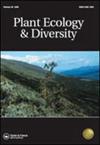Stand-alone or co-occurring invasive plant species do not modify the diversity of the soil N2-fixing bacterial community
IF 1.6
4区 生物学
Q2 PLANT SCIENCES
引用次数: 12
Abstract
ABSTRACT Background: Soil N2-fixing bacterial (SNB) communities may play a vital role in plant invasion. Two or more invasive plant species (invaders) may coexist in the same ecosystem. Thus, it is important to assess the effects of co-invasion on SNB communities to elucidate the ecological mechanisms of plant invasion. Aims: The effects of two co-occurring invaders (Erigeron annuus and Solidago canadensis) with different coverage classes on SNB communities were evaluated via a comparative study. Methods: SNB communities were assessed using a high-throughput sequencing approach. Results: The invasion of E. annuus and/or S. canadensis, regardless of coverage, did not pose pronounced effects on soil physicochemical properties and the diversity of SNB. Soil electrical conductivity was the most important environmental factors explaining the variation in SNB composition. This phenomenon may be chiefly attributed to the fact that the shifts in soil electrical conductivity can recruit obvious variations in the resource utilisation and acquisition patterns of carbon for the metabolism of soil microorganisms. Plant Shannon’s diversity was also one key factor influencing the community structure of SNB, but its direct effects are less powerful than soil electrical conductivity. However, the negatively indirect effects of plant Shannon’s diversity on the Shannon index, ACE index, and Chao1 index of SNB were noticeably greater than soil electrical conductivity. Therefore, the effects of plant Shannon’s diversity on the community structure of SNB may largely be attributed to the variation in soil electrical conductivity via the released root exudates and then modify the resource availability pattern of SNB. Conclusions: SNB diversity is more influenced by changes in soil variables like soil electrical conductivity than by the presence/coverage of invasive plant species.单独或共同发生的入侵植物物种不会改变土壤固氮细菌群落的多样性
背景:土壤固氮细菌(SNB)群落可能在植物入侵中起重要作用。两种或两种以上的入侵植物可能在同一生态系统中共存。因此,评估共入侵对SNB群落的影响对阐明植物入侵的生态机制具有重要意义。目的:通过比较研究,评价两种不同盖度的共发生入侵植物(Erigeron annuus和Solidago canada)对SNB群落的影响。方法:采用高通量测序方法评估SNB群落。结果:不论覆盖程度如何,黄花仙子和/或加拿大仙子的入侵对土壤理化性质和SNB多样性均无显著影响。土壤电导率是解释SNB组成变化最重要的环境因子。这一现象的主要原因可能是土壤电导率的变化导致土壤微生物对碳的资源利用和碳的获取模式发生明显变化。植物香农多样性也是影响小檗群落结构的关键因素之一,但其直接影响不如土壤电导率大。而植物Shannon多样性对SNB Shannon指数、ACE指数和Chao1指数的间接负向影响显著大于土壤电导率。因此,植物香农多样性对SNB群落结构的影响可能主要是通过根系分泌物释放土壤电导率的变化,进而改变SNB资源有效性格局。结论:SNB多样性受土壤电导率等土壤变量变化的影响大于入侵植物存在/覆盖的影响。
本文章由计算机程序翻译,如有差异,请以英文原文为准。
求助全文
约1分钟内获得全文
求助全文
来源期刊

Plant Ecology & Diversity
PLANT SCIENCES-
CiteScore
3.30
自引率
0.00%
发文量
26
审稿时长
3 months
期刊介绍:
Plant Ecology and Diversity is an international journal for communicating results and novel ideas in plant science, in print and on-line, six times a year. All areas of plant biology relating to ecology, evolution and diversity are of interest, including those which explicitly deal with today''s highly topical themes, such as biodiversity, conservation and global change. We consider submissions that address fundamental questions which are pertinent to contemporary plant science. Articles concerning extreme environments world-wide are particularly welcome.
Plant Ecology and Diversity considers for publication original research articles, short communications, reviews, and scientific correspondence that explore thought-provoking ideas.
To aid redressing ‘publication bias’ the journal is unique in reporting, in the form of short communications, ‘negative results’ and ‘repeat experiments’ that test ecological theories experimentally, in theoretically flawless and methodologically sound papers. Research reviews and method papers, are also encouraged.
Plant Ecology & Diversity publishes high-quality and topical research that demonstrates solid scholarship. As such, the journal does not publish purely descriptive papers. Submissions are required to focus on research topics that are broad in their scope and thus provide new insights and contribute to theory. The original research should address clear hypotheses that test theory or questions and offer new insights on topics of interest to an international readership.
 求助内容:
求助内容: 应助结果提醒方式:
应助结果提醒方式:


